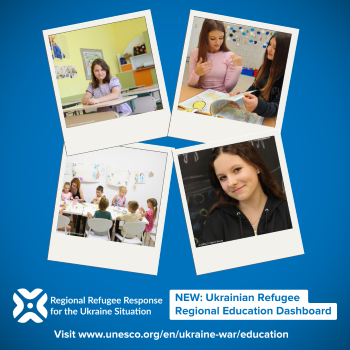New data: Progress and challenges for the education of displaced pupils from Ukraine in Europe

This interactive platform incorporates and extends the insights from a related 2024 European Commission report with latest data from a new 2025 inter-agency analysis. It brings together:
- A regional overview of data from European countries with available data on Ukrainian refugee education.
- Profiles of seven countries with Refugee Response Plans and comparable data: Bulgaria, Czechia, Hungary, Republic of Moldova, Poland, Romania, and Slovakia.
- A repository of data, information, and evidence from European host countries.
Since the start of Russia’s war of aggression against Ukraine, the number of Ukrainian learners enrolled in the education systems of their European host countries has steadily increased. In the ten countries surveyed in UNHCR’s 2024 Socio-Economic Insights Survey (Bulgaria, Czech Republic, Hungary, Republic of Moldova, Poland, Romania, Slovakia, Estonia, Latvia and Lithuania), on average 79% of displaced children are now enrolled in compulsory education in the host country.
However, challenges remain. According to the new analysis:
- Children and youth with beginner-level language skills show enrolment rates 50% lower than their more fluent peers.
- Children and youth with disabilities and recent arrivals also face lower participation rates.
- 6% of children are reported not to be in any form of schooling.
- 29% follow both host country schooling and the Ukrainian curriculum online. This dual burden of learning can be an intensive workload leading to reduced well-being.
The European Commission continues to support Member States in responding to these challenges by:
- Funding education initiatives through Erasmus+, including textbook printing, teacher training, and school integration.
- Providing policy guidance and resources for educators to facilitate the integration of Ukrainian learners through a dedicated page on the European School Education Platform
- Promoting mutual recognition of qualifications with Ukraine.
- Mobilising EU funding under the Recovery and Resilience Facility, Cohesion Policy Funds and Technical Support Instrument to support Member States in their integration efforts.
A key takeaway from the new dashboard and interagency analysis is the call for more data and exchange of experiences on learning outcomes and well-being of Ukrainian learners, to help shape more inclusive education systems.
Additional information
-
Education type:School Education
-
Target audience ISCED:Primary education (ISCED 1)Lower secondary education (ISCED 2)Upper secondary education (ISCED 3)
